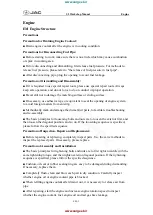
Service Intervals
Regular maintenance is the key to ensuring
the continued reliability and efficiency of your
Model S.
Rotate the tires every 5000 miles (8000 km)
(except on Performance Plus models),
maintain the correct tire pressures, and take
Model S to Tesla at the regularly scheduled
maintenance intervals of every 12 months, or
every 12,500 miles (20,000 km), whichever
comes first. It is also important to perform the
daily and monthly checks described below.
Model S must be serviced by Tesla-certified
technicians. Damages or failures caused by
maintenance or repairs performed by non-
Tesla certified technicians are not covered by
the warranty.
Daily Checks
•
Check the Battery’s charge level,
displayed on the instrument panel.
•
Check that all exterior lights, horn, turn
signals, and wipers and washers are
working.
•
Check the operation of the brakes,
including the parking brake.
•
Check the operation of the seat belts
(see
Seat Belts
on page 18).
•
Look for fluid deposits underneath
Model S that might indicate a leak. It is
normal for a small pool of water to form
(caused by the air conditioning system’s
dehumidifying process).
Monthly Checks
•
Check the mileage to determine if the
tires need to be rotated (every 5000
miles/8000 km, except on Performance
Plus models), and check the condition and
pressure of each tire (see
Tire Care and
Maintenance
on page 94).
•
Check washer fluid level and top up if
necessary (see
Topping Up Washer Fluid
on page 110).
•
Check that the air conditioning system is
operating (see
Climate Controls
on page
70).
Warning: Contact Tesla immediately if
you notice any significant or sudden drop
in fluid levels or uneven tire wear.
Fluid Replacement Intervals
Do not change or top up Battery coolant and
brake fluid yourself. Tesla service technicians
replace fluids at the regularly scheduled
service intervals:
•
Brake fluid - every 2 years or 24,000 miles
(40,000 km), whichever comes first.
•
Battery coolant - every 4 years or 48,000
miles (80,000 km), whichever comes first.
Note: Any damage from opening the Battery
coolant reservoir is excluded from the
warranty.
High Voltage Safety
Your Model S has been designed and built
with safety as a priority. However, be aware of
these precautions to protect yourself from the
risk of injury inherent in all high-voltage
systems:
•
Read and follow all instructions provided
on the labels that are attached to Model S.
These labels are there for your safety.
•
The high voltage system has no user-
serviceable parts. Do not disassemble,
remove or replace high voltage
components, cables or connectors. High
voltage cables are colored orange for
easy identification.
•
If an accident occurs, do not touch any
high voltage wiring, connectors, or
components connected to the wiring.
•
In the unlikely event that a fire occurs,
immediately contact your local fire
emergency responders.
Warning: Always disconnect the charge
cable before working underneath
Model S, even if charging is not in
progress.
Warning: Keep your hands and clothing
away from cooling fans. Some fans
operate even when Model S is powered
off.
Caution: Some fluids (battery acid,
Battery coolant, brake fluid, windshield
washer additives, etc.) used in motor
vehicles are poisonous and should not be
inhaled, swallowed, or brought into
contact with open wounds. For your
safety, always read and follow
instructions printed on fluid containers.
Maintenance
Maintenance
93
















































